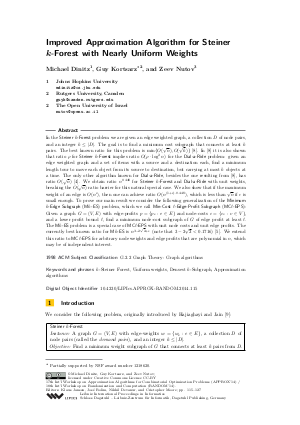Improved Approximation Algorithm for Steiner k-Forest with Nearly Uniform Weights
Authors Michael Dinitz, Guy Kortsarz, Zeev Nutov
-
Part of:
Volume:
Approximation, Randomization, and Combinatorial Optimization. Algorithms and Techniques (APPROX/RANDOM 2014)
Part of: Series: Leibniz International Proceedings in Informatics (LIPIcs)
Part of: Conference: International Conference on Randomization and Computation (RANDOM)
Part of: Conference: International Conference on Approximation Algorithms for Combinatorial Optimization Problems (APPROX) - License:
 Creative Commons Attribution 3.0 Unported license
Creative Commons Attribution 3.0 Unported license
- Publication Date: 2014-09-04
File

PDF
LIPIcs.APPROX-RANDOM.2014.115.pdf
- Filesize: 497 kB
- 13 pages
Document Identifiers
Subject Classification
Keywords
- k-Steiner Forest; Uniform weights; Densest k-Subgraph; Approximation algorithms
Metrics
- Access Statistics
-
Total Accesses (updated on a weekly basis)
0PDF Downloads0Metadata Views
Abstract
In the Steiner k-Forest problem we are given an edge weighted graph, a collection D of node pairs, and an integer k \leq |D|. The goal is to find a minimum cost subgraph that connects at least k pairs. The best known ratio for this problem is min{O(sqrt{n}),O(sqrt{k})} [Gupta et al., 2008]. In [Gupta et al., 2008] it is also shown that ratio rho for Steiner k-Forest implies ratio O(rho log^2 n) for the Dial-a-Ride problem: given an edge weighted graph and a set of items with a source and a destination each, find a minimum length tour to move each object from its source to destination, but carrying at most k objects at a time. The only other algorithm known for Dial-a-Ride, besides the one resulting from [Gupta et al., 2008], has ratio O(sqrt{n}) [Charikar and Raghavachari, 1998]. We obtain ratio n^{0.448} for Steiner k-Forest and Dial-a-Ride with unit weights, breaking the O(sqrt{n}) ratio barrier for this natural special case. We also show that if the maximum weight of an edge is O(n^{epsilon}), then one can achieve ratio O(n^{(1+epsilon) 0.448}), which is less than sqrt{n} if epsilon is small enough. To prove our main result we consider the following generalization of the Minimum k-Edge Subgraph (Mk-ES) problem, which we call Min-Cost l-Edge-Profit Subgraph (MCl-EPS): Given a graph G=(V,E) with edge-profits p={p_e: e in E} and node-costs c={c_v: v in V}, and a lower profit bound l, find a minimum node-cost subgraph of G of edge profit at least l. The Mk-ES problem is a special case of MCl-EPS with unit node costs and unit edge profits. The currently best known ratio for Mk-ES is n^{3-2*sqrt{2} + epsilon} (note that 3-2*sqrt{2} < 0.1716). We extend this ratio to MCl-EPS for arbitrary node weights and edge profits that are polynomial in n, which may be of independent interest.
Cite As Get BibTex
Michael Dinitz, Guy Kortsarz, and Zeev Nutov. Improved Approximation Algorithm for Steiner k-Forest with Nearly Uniform Weights. In Approximation, Randomization, and Combinatorial Optimization. Algorithms and Techniques (APPROX/RANDOM 2014). Leibniz International Proceedings in Informatics (LIPIcs), Volume 28, pp. 115-127, Schloss Dagstuhl – Leibniz-Zentrum für Informatik (2014)
https://doi.org/10.4230/LIPIcs.APPROX-RANDOM.2014.115
BibTex
@InProceedings{dinitz_et_al:LIPIcs.APPROX-RANDOM.2014.115,
author = {Dinitz, Michael and Kortsarz, Guy and Nutov, Zeev},
title = {{Improved Approximation Algorithm for Steiner k-Forest with Nearly Uniform Weights}},
booktitle = {Approximation, Randomization, and Combinatorial Optimization. Algorithms and Techniques (APPROX/RANDOM 2014)},
pages = {115--127},
series = {Leibniz International Proceedings in Informatics (LIPIcs)},
ISBN = {978-3-939897-74-3},
ISSN = {1868-8969},
year = {2014},
volume = {28},
editor = {Jansen, Klaus and Rolim, Jos\'{e} and Devanur, Nikhil R. and Moore, Cristopher},
publisher = {Schloss Dagstuhl -- Leibniz-Zentrum f{\"u}r Informatik},
address = {Dagstuhl, Germany},
URL = {https://drops.dagstuhl.de/entities/document/10.4230/LIPIcs.APPROX-RANDOM.2014.115},
URN = {urn:nbn:de:0030-drops-46925},
doi = {10.4230/LIPIcs.APPROX-RANDOM.2014.115},
annote = {Keywords: k-Steiner Forest; Uniform weights; Densest k-Subgraph; Approximation algorithms}
}
